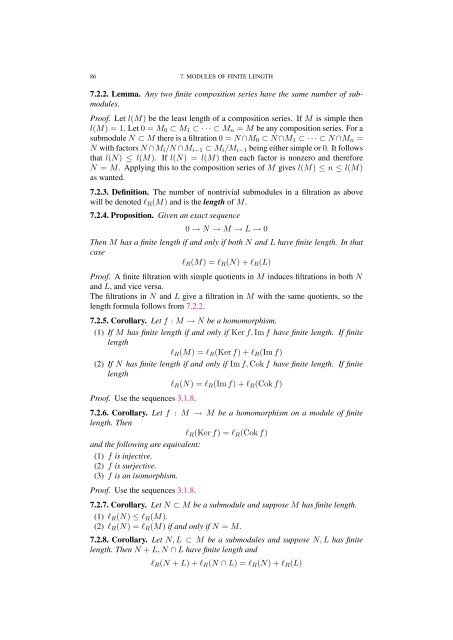Commutative algebra - Department of Mathematical Sciences - old ...
Commutative algebra - Department of Mathematical Sciences - old ...
Commutative algebra - Department of Mathematical Sciences - old ...
Create successful ePaper yourself
Turn your PDF publications into a flip-book with our unique Google optimized e-Paper software.
86 7. MODULES OF FINITE LENGTH<br />
7.2.2. Lemma. Any two finite composition series have the same number <strong>of</strong> submodules.<br />
Pro<strong>of</strong>. Let l(M) be the least length <strong>of</strong> a composition series. If M is simple then<br />
l(M) = 1. Let 0 = M0 ⊂ M1 ⊂ · · · ⊂ Mn = M be any composition series. For a<br />
submodule N ⊂ M there is a filtration 0 = N ∩M0 ⊂ N ∩M1 ⊂ · · · ⊂ N ∩Mn =<br />
N with factors N ∩Mi/N ∩Mi−1 ⊂ Mi/Mi−1 being either simple or 0. It follows<br />
that l(N) ≤ l(M). If l(N) = l(M) then each factor is nonzero and therefore<br />
N = M. Applying this to the composition series <strong>of</strong> M gives l(M) ≤ n ≤ l(M)<br />
as wanted.<br />
7.2.3. Definition. The number <strong>of</strong> nontrivial submodules in a filtration as above<br />
will be denoted ℓR(M) and is the length <strong>of</strong> M.<br />
7.2.4. Proposition. Given an exact sequence<br />
0 → N → M → L → 0<br />
Then M has a finite length if and only if both N and L have finite length. In that<br />
case<br />
ℓR(M) = ℓR(N) + ℓR(L)<br />
Pro<strong>of</strong>. A finite filtration with simple quotients in M induces filtrations in both N<br />
and L, and vice versa.<br />
The filtrations in N and L give a filtration in M with the same quotients, so the<br />
length formula follows from 7.2.2.<br />
7.2.5. Corollary. Let f : M → N be a homomorphism.<br />
(1) If M has finite length if and only if Ker f, Im f have finite length. If finite<br />
length<br />
ℓR(M) = ℓR(Ker f) + ℓR(Im f)<br />
(2) If N has finite length if and only if Im f, Cok f have finite length. If finite<br />
length<br />
ℓR(N) = ℓR(Im f) + ℓR(Cok f)<br />
Pro<strong>of</strong>. Use the sequences 3.1.8.<br />
7.2.6. Corollary. Let f : M → M be a homomorphism on a module <strong>of</strong> finite<br />
length. Then<br />
ℓR(Ker f) = ℓR(Cok f)<br />
and the following are equivalent:<br />
(1) f is injective.<br />
(2) f is surjective.<br />
(3) f is an isomorphism.<br />
Pro<strong>of</strong>. Use the sequences 3.1.8.<br />
7.2.7. Corollary. Let N ⊂ M be a submodule and suppose M has finite length.<br />
(1) ℓR(N) ≤ ℓR(M).<br />
(2) ℓR(N) = ℓR(M) if and only if N = M.<br />
7.2.8. Corollary. Let N, L ⊂ M be a submodules and suppose N, L has finite<br />
length. Then N + L, N ∩ L have finite length and<br />
ℓR(N + L) + ℓR(N ∩ L) = ℓR(N) + ℓR(L)
















